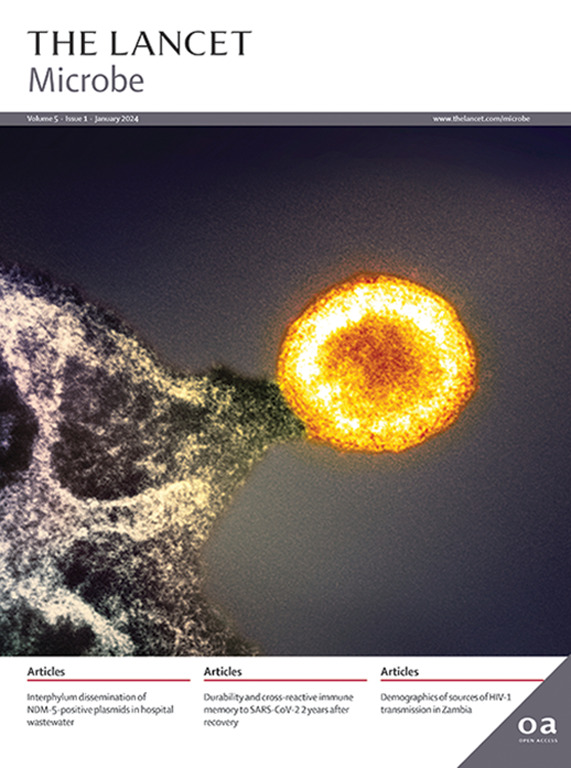Molecular features of the serological IgG repertoire elicited by egg-based, cell-based, or recombinant haemagglutinin-based seasonal influenza vaccines: a comparative, prospective, observational cohort study
IF 20.9
1区 生物学
Q1 INFECTIOUS DISEASES
引用次数: 0
Abstract
Background
Egg-based inactivated quadrivalent seasonal influenza vaccine (eIIV4), cell culture-based inactivated quadrivalent seasonal influenza vaccine (ccIIV4), and recombinant haemagglutinin (HA)-based quadrivalent seasonal influenza vaccine (RIV4) have been licensed for use in the USA. In this study, we used antigen-specific serum proteomics analysis to assess how the molecular composition and qualities of the serological antibody repertoires differ after seasonal influenza immunisation by each of the three vaccines and how different vaccination platforms affect the HA binding affinity and breadth of the serum antibodies that comprise the polyclonal response.
Methods
In this comparative, prospective, observational cohort study, we included female US health-care personnel (mean age 47·6 years [SD 8]) who received a single dose of RIV4, eIIV4, or ccIIV4 during the 2018–19 influenza season at Baylor Scott & White Health (Temple, TX, USA). Eligible individuals were selected based on comparable day 28 serum microneutralisation titres and similar vaccination history. Laboratory investigators were blinded to assignment until testing was completed. The preplanned exploratory endpoints were assessed by deconvoluting the serological repertoire specific to A/Singapore/INFIMH-16–0019/2016 (H3N2) HA before (day 0) and after (day 28) immunisation using bottom-up liquid chromatography–mass spectrometry proteomics (referred to as Ig-Seq) and natively paired variable heavy chain–variable light chain high-throughput B-cell receptor sequencing (referred to as BCR-Seq). Features of the antigen-specific serological repertoire at day 0 and day 28 for the three vaccine groups were compared. Antibodies identified with high confidence in sera were recombinantly expressed and characterised in depth to determine the binding affinity and breadth to time-ordered H3 HA proteins.
Findings
During September and October of the 2018–19 influenza season, 15 individuals were recruited and assigned to receive RIV4 (n=5), eIIV4 (n=5), or ccIIV4 (n=5). For all three cohorts, the serum antibody repertoire was dominated by back-boosted antibody lineages (median 98% [95% CI 88–99]) that were present in the serum before vaccination. Although vaccine platform-dependent differences were not evident in the repertoire diversity, somatic hypermutation, or heavy chain complementarity determining region 3 biochemical features, antibodies boosted by RIV4 showed substantially higher binding affinity to the vaccine H3/HA (median half-maximal effective concentration [EC50] to A/Singapore/INFIMH-16–0019/2016 HA: 0·037 μg/mL [95% CI 0·012–0·12] for RIV4; 4·43 μg/mL [0·030–100·0] for eIIV4; and 18·50 μg/mL [0·99–100·0] μg/mL for ccIIV4) and also the HAs from contemporary H3N2 strains than did those elicited by eIIV4 or ccIIV4 (median EC50 to A/Texas/50/2012 HA: 0·037 μg/mL [0·017–0·32] for RIV4; 1·10 μg/mL [0·045–100] for eIIV4; and 12·6 μg/mL [1·8–100] for ccIIV4). Comparison of B-cell receptor sequencing repertoires on day 7 showed that eIIV4 increased the median frequency of canonical egg glycan-targeting B cells (0·20% [95% CI 0·067–0·37] for eIIV4; 0·058% [0·050–0·11] for RIV4; and 0·035% [0–0·062] for ccIIV4), whereas RIV4 vaccination decreased the median frequency of B-cell receptors displaying stereotypical features associated with membrane proximal anchor-targeting antibodies (0·062% [95% CI 0–0·084] for RIV4; 0·12% [0·066–0·16] for eIIV4; and 0·18% [0·016–0·20] for ccIIV4). In exploratory analysis, we characterised the structure of a highly abundant monoclonal antibody that binds to both group 1 and 2 HAs and recognises the HA trimer interface, despite its sequence resembling the stereotypical sequence motif found in membrane-proximal anchor binding antibodies.
Interpretation
Although all three licensed seasonal influenza vaccines elicit serological antibody repertoires with indistinguishable features shaped by heavy imprinting, the RIV4 vaccine selectively boosts higher affinity monoclonal antibodies to contemporary strains and elicits greater serum binding potency and breadth, possibly as a consequence of the multivalent structural features of the HA immunogen in this vaccine formulation. Collectively, our findings show advantages of RIV4 vaccines and more generally highlight the benefits of multivalent HA immunogens in promoting higher affinity serum antibody responses.
Funding
Centers for Disease Control and Prevention, National Institutes of Health, and Bill & Melinda Gates Foundation.
基于蛋的、基于细胞的或基于重组血凝素的季节性流感疫苗引发的血清IgG库的分子特征:一项比较、前瞻性、观察性队列研究
背景:基于鸡蛋的四价季节性流感灭活疫苗(eIIV4)、基于细胞培养的四价季节性流感灭活疫苗(ccIIV4)和基于重组血凝素(HA)的四价季节性流感疫苗(RIV4)已获准在美国使用。在这项研究中,我们使用抗原特异性血清蛋白质组学分析来评估三种疫苗接种季节性流感疫苗后血清抗体谱的分子组成和质量的差异,以及不同的疫苗接种平台如何影响构成多克隆应答的HA结合亲和力和血清抗体的宽度。方法:在这项比较、前瞻性、观察性队列研究中,我们纳入了2018-19年流感季节期间在Baylor Scott & White Health (Temple, TX, USA)接受单剂量RIV4、eIIV4或ccIIV4的美国女性卫生保健人员(平均年龄47.6岁[SD 8])。根据可比的第28天血清微量中和滴度和相似的疫苗接种史选择符合条件的个体。在测试完成之前,实验室调查人员对任务不知情。预先计划的探索性终点是通过在免疫前(第0天)和免疫后(第28天)使用自下而上的液相色谱-质谱蛋白质组学(称为Ig-Seq)和天然配对的可变重链-可变轻链高通量b细胞受体测序(称为BCR-Seq)对A/Singapore/INFIMH-16-0019/2016 (H3N2) HA特异性血清学库进行解旋来评估的。比较三个疫苗组在第0天和第28天抗原特异性血清学库的特征。在血清中鉴定出高可信度的抗体进行重组表达和深度表征,以确定与时间顺序的H3 HA蛋白的结合亲和力和广度。结果:在2018- 2019年流感季节的9月和10月,招募了15名个体并分配接受RIV4 (n=5), eIIV4 (n=5)或ccIIV4 (n=5)。在所有三个队列中,血清抗体库以接种前血清中存在的反向增强抗体谱系(中位数为98% [95% CI 88-99])为主。尽管疫苗平台依赖性差异在库多样性、体细胞超突变或决定3区生化特征的重链互补性方面不明显,但RIV4增强的抗体与疫苗H3/HA的结合亲和力显著提高(对A/Singapore/INFIMH-16-0019/2016 HA的中位半最大有效浓度[EC50]: 0.037 μg/mL [95% CI 0.012 - 0.12];eIIV4为4.43 μg/mL[0·030 ~ 100·0];与eIIV4或ccIIV4诱导的H3N2株相比,H3N2株的HA值为18.50 μg/mL (0.99 ~ 100 μg/mL), RIV4株的中位EC50为0.037 μg/mL (0.017 ~ 0.32);eIIV4为1·10 μg/mL[0·045-100];ccIIV4为12.6 μg/mL[1·8 ~ 100])。第7天的B细胞受体测序谱比较显示,eIIV4增加了典型蛋聚糖靶向B细胞的中位数频率(0.20% [95% CI 0.067 - 0.37]);RIV4为0.058% [0.050 - 0.11];ccIIV4和0.035%[0- 0.062]),而RIV4疫苗降低了与膜近端锚定靶向抗体相关的典型特征的b细胞受体的中位数频率(0.062% [95% CI 0- 0.084]);eIIV4为0.12% [0.066 - 0.16];ccIIV4为0.18%[0.016 - 0.20]。在探索性分析中,我们描述了一种高度丰富的单克隆抗体的结构,该抗体与1组和2组HA结合,并识别HA三聚体界面,尽管其序列类似于膜近端锚定结合抗体中发现的典型序列基序。解释:尽管所有三种已获许可的季节性流感疫苗均可诱导血清学抗体库,其特征由重印迹形成,难以区分,但RIV4疫苗选择性地增强了针对当代菌株的高亲和力单克隆抗体,并引发了更大的血清结合效力和广度,这可能是由于该疫苗制剂中HA免疫原的多价结构特征所致。总的来说,我们的研究结果显示了RIV4疫苗的优势,更普遍地强调了多价HA免疫原在促进高亲和力血清抗体反应方面的益处。资助:疾病控制和预防中心,国家卫生研究院,比尔和梅林达·盖茨基金会。
本文章由计算机程序翻译,如有差异,请以英文原文为准。
求助全文
约1分钟内获得全文
求助全文
来源期刊

Lancet Microbe
Multiple-
CiteScore
27.20
自引率
0.80%
发文量
278
审稿时长
6 weeks
期刊介绍:
The Lancet Microbe is a gold open access journal committed to publishing content relevant to clinical microbiologists worldwide, with a focus on studies that advance clinical understanding, challenge the status quo, and advocate change in health policy.
 求助内容:
求助内容: 应助结果提醒方式:
应助结果提醒方式:


